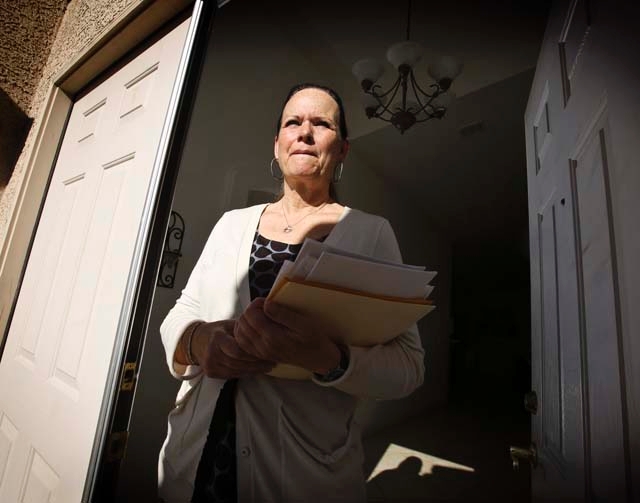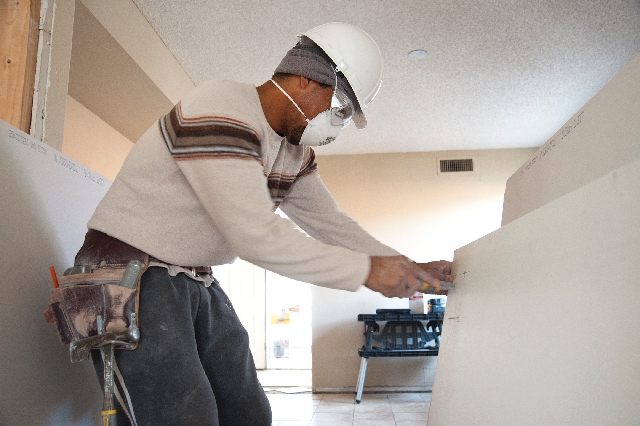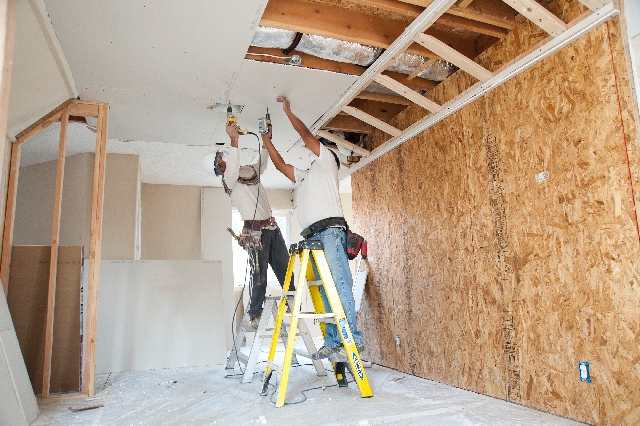Southern Nevada homeowners starving for state, federal aid
First it was the Home Affordable Mortgage Program and an alphabet soup of offshoots such as HAFA and HARP. Then came the Neighborhood Stabilization Program and Hardest-Hit Fund.
The government has thrown hundreds of millions of dollars at fixing Nevada’s beleaguered housing market, though very little of the money has trickled into the hands of people who need it most.
Nevada remains one of the states with the highest rate of foreclosure filings, homes with negative equity and people living in their homes without making mortgage payments.
“There hasn’t been one program that has fulfilled the promises made when they first came out,” Las Vegas housing analyst Dennis Smith said. “Every program has come up far short of what we were led to believe how it would help our situation.”
Although they may have had good intentions, many of the programs were first and foremost “political posturing,” he said.
Now the state has taken its own steps at saving homeowners from the brink of foreclosure.
Bruce Breslow can’t speak for previous government programs, but he believes the Home Retention program unveiled in January is something banks should have started long ago.
The estimated 52,000 homeowners who are underwater and seriously delinquent on mortgage payments — the “shadow inventory” — continue to impede housing recovery, the director of Nevada’s Department of Business and Industry said.
Nevada homeowners had $11 billion in negative home equity as of last year, he said.
Breslow’s plan, in partnership with Housing and Urban Development and the U.S. Treasury, is to find a pool of underwater, delinquent mortgages held by the Federal Housing Administration and buy them at a 30 percent discount from current market value.
The homeowner could then qualify for a new 30-year, fixed-rate mortgage at the home’s current value, completely eliminating the underwater portion. It’s the only way for them to start building equity in their home and motivate them to maintain the property, Breslow said.
“Our program will bring a homeowner into position to build equity again,” he said. “Hedge funds have been doing this across the country, buying (mortgage) notes from FHA, (federal mortgage lenders) Fannie (Mae) and Freddie (Mac). They try to help the homeowner by refinancing, but they don’t completely wipe out the underwater debt. This one is specific to go after the shadow inventory.”
A nonprofit agency will administer the program using $49 million from Nevada’s portion of the National Mortgage Settlement and $100 million from the U.S. Treasury, Breslow said. Oregon and other states have variations of the program, but Nevada is unique in this approach to addressing underwater homes, he said.
Nevada Attorney General Catherine Cortez Masto recommended funding for the Home Retention program, but said she still wants to see the “business plan.”
Breslow said he’s working on the plan, along with his deputy director, that shows the fund could acquire 700 to 800 homes in the first year. It will be presented to a legislative committee at the end of March or early April; it will be at least six months before any homes are purchased. The Treasury’s commitment hinges on the Legislature’s approval of funding.
It’s not a voluntary program, Breslow said. To qualify, a homeowner’s loan must be among the pool acquired by the state from FHA or other government-sponsored enterprises. FHA, in a meeting with Nevada officials, said it has the ability to identify a pool of homes that could be sold to the state, and is willing to sell at a 30 percent discount, he said.
Many homeowners won’t qualify for the program. Some of the homes in the pool may already be vacant or abandoned, or occupied by someone in “strategic default,” knowing it will take two or three years for their lender to foreclose. In that case, the program will work toward a quick foreclosure and get a qualified owner-occupant into the home, Breslow said.
BEYOND HELP
Tara Newberry of the Connaghan Newberry law firm said she’s counseled many homeowners over the past few years who don’t qualify for the programs, and many of them simply can’t be saved.
If fair market value of their home is 65 percent below what they owe, they’re probably not going to pay it off and the notion that the value will return is far-fetched, she said.
“A lot of people are emotionally attached to their home. People who think they can sit and not pay because of the foreclosure embargo here in Nevada are not going to get principal reductions,” Newberry said. “Bank of America is starting to roll on foreclosure activity. Exit with grace, a short sale or deed in lieu (of foreclosure).”
Newberry said Las Vegas could get hit with a “foreclosure tsunami.” Clark County notices of default fell from 4,000 a month to less than 1,000 a month after Nevada’s robo-signing law went into effect in October 2011, Newberry said, but have crept back up and topped 1,500 in February.
North Las Vegas resident Cathy Thran sought a principal reduction through the U.S. Treasury’s Hardest-Hit Fund, which provided $194 million to assist Nevada homeowners at risk of default or foreclosure. The program included mortgage assistance, principal reduction and reinstatement of past-due mortgages.
Thran completed required financial counseling and was told to contact someone at Nevada Affordable Housing Assistance Corp., the nonprofit agency approved to oversee the fund, who could give her more information on principal reduction. That was around December when the fund stopped accepting applications. Officials said they couldn’t keep pace with the workload.
Thran said NAHAC has had two months to figure out where it is with applications and money, but still isn’t taking applications. She said she thinks the problem is mismanagement.
The application process will reopen soon, though no exact date has been set, NAHAC Executive Director Candice Kelley said. The fund paid out $7.2 million in January and $8.9 million in February, mostly in principal reduction and subsidized mortgage payments for unemployed and underemployed Nevadans. March will be another strong month, she said.
Total assistance provided through the end of 2012 was $28.4 million, compared with just $3.5 million through 2011.
“The program has been in such high demand,” Kelley said. “We assisted more than 1,800 homeowners in February. It’s definitely evident in the trajectory and that pattern will hold true through March and beyond.”
After reaching a dead end with the Hardest-Hit Fund, Thran proceeded to refinance her loan with Wells Fargo through HARP, or the Home Affordable Refinance Program, which would reduce her monthly payment by more than $400.
“I wanted to apply for the principal reduction before I refinanced, but Wells Fargo had no idea what I was talking about,” Thran said. “They also warned me if I waited too long, they may discontinue HARP and I would be out of luck for refinancing. I probably should have waited, but didn’t.”
Thran said there are so many programs for Las Vegas homeowners because they’re so far underwater, but people don’t know about them.
LAYING INFRASTRUCTURE
Masto has asked the Legislature to set aside $33 million from the National Mortgage Settlement to build an “infrastructure” to help distressed homeowners navigate the federal programs available to them.
She rolled out her “Home Again” marketing program and hotline (855-457-4638) in January using $11.7 million in approved funding for the first year, partnering with HUD-certified counselors and legal aid to address homeowners’ needs and determine eligibility for existing federal programs.
Masto said more than 6,000 people called the hotline during the first month and are being scheduled for counseling.
“What we were hearing is there’s so many programs out there, nobody knows where to start,” Masto said in an interview. “We were able to identify homeowners on the hotline that would be eligible for restitution or modification or short sale.”
Federal programs such as HAMP were not much help for Nevada homeowners because the loan-to-value ratio was capped at 115 percent, whereas most Nevadans had 150 percent or higher loan-to-value, Masto said. Even after the caps were removed, the program failed to achieve expected results, she said.
“A lot of programs are somewhat helpful, but are more of a Band-Aid,” Breslow said. “If you’re down $30,000 to $50,000, the Hardest-Hit Fund is very helpful, but if you’re $200,000 underwater, you can’t get that home back to current value, no matter what homeowner program they’re working with. They’re less likely to keep that home and water the lawn.”
Landscaping is usually the first work to be done at homes purchased through the Neighborhood Stabilization Program, said Tim Whitright, manager of Las Vegas Neighborhood Development.
The $4 billion program, announced by President Barack Obama during a 2009 visit to Las Vegas, provides funding to purchase foreclosed homes in blighted neighborhoods nationwide, repair them and resell them to first-time homebuyers.
Whitright said the program helped 146 families purchase abandoned or foreclosed homes in Las Vegas. An estimated 40,481 single-family homes are sitting vacant in the Las Vegas Valley, or 8.4 percent of all homes, a fourth-quarter report from the Lied Institute for Real Estate Studies shows.
About 25 percent of the Neighborhood Stabilization Program, fund goes toward long-term rentals for low-income households. The strategy is to dry up the foreclosure market and boost property values, Whitright said.
John DiMilte of J&A Contracting said he’s renovated about 25 homes in Las Vegas and Henderson through the Neighborhood Stabilization Program. He estimated that each home requires $12,000 to $35,000 in work.
“It’s helped me keep my business going,” DiMilte said as he supervised a crew putting in new tile, plumbing, toilets and doors at a home near Lake Mead and Rainbow boulevards.
But Las Vegas home investor Zolt Szorenyi said the Neighborhood Stabilization Program is too restrictive and takes up to a year to put a home back on the market. Meanwhile, private investors are “flipping” homes in 60 to 70 days.
Nonprofit groups were unable to acquire bank-owned properties, and lenders won’t finance a home that’s missing the air conditioner and other essentials, he said.
“Nonprofits haven’t done anything because their hands are tied. There’s no way they can buy and sell a house without losing money for the government,” Szorenyi said.
Contact reporter Hubble Smith at hsmith@reviewjournal.com or 702-383-0491.






























